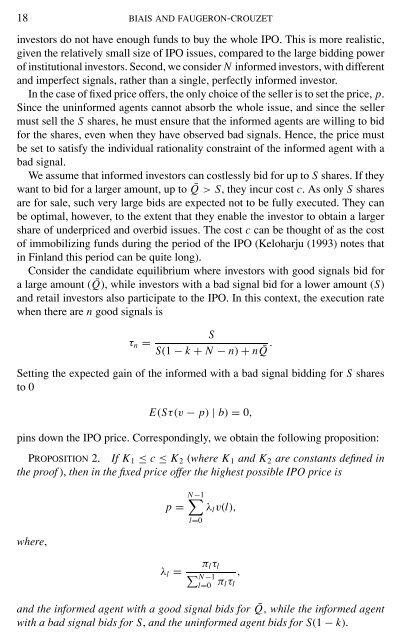IPO Auctions: English, Dutch, ... French, and Internet
IPO Auctions: English, Dutch, ... French, and Internet
IPO Auctions: English, Dutch, ... French, and Internet
You also want an ePaper? Increase the reach of your titles
YUMPU automatically turns print PDFs into web optimized ePapers that Google loves.
18 BIAIS AND FAUGERON-CROUZET<br />
investors do not have enough funds to buy the whole <strong>IPO</strong>. This is more realistic,<br />
given the relatively small size of <strong>IPO</strong> issues, compared to the large bidding power<br />
of institutional investors. Second, we consider N informed investors, with different<br />
<strong>and</strong> imperfect signals, rather than a single, perfectly informed investor.<br />
In the case of fixed price offers, the only choice of the seller is to set the price, p.<br />
Since the uninformed agents cannot absorb the whole issue, <strong>and</strong> since the seller<br />
must sell the S shares, he must ensure that the informed agents are willing to bid<br />
for the shares, even when they have observed bad signals. Hence, the price must<br />
be set to satisfy the individual rationality constraint of the informed agent with a<br />
bad signal.<br />
We assume that informed investors can costlessly bid for up to S shares. If they<br />
want to bid for a larger amount, up to ¯Q > S, they incur cost c. As only S shares<br />
are for sale, such very large bids are expected not to be fully executed. They can<br />
be optimal, however, to the extent that they enable the investor to obtain a larger<br />
share of underpriced <strong>and</strong> overbid issues. The cost c can be thought of as the cost<br />
of immobilizing funds during the period of the <strong>IPO</strong> (Keloharju (1993) notes that<br />
in Finl<strong>and</strong> this period can be quite long).<br />
Consider the c<strong>and</strong>idate equilibrium where investors with good signals bid for<br />
a large amount ( ¯Q), while investors with a bad signal bid for a lower amount (S)<br />
<strong>and</strong> retail investors also participate to the <strong>IPO</strong>. In this context, the execution rate<br />
when there are n good signals is<br />
S<br />
τn =<br />
S(1 − k + N − n) + n ¯Q .<br />
Setting the expected gain of the informed with a bad signal bidding for S shares<br />
to 0<br />
E(Sτ(v − p) | b) = 0,<br />
pins down the <strong>IPO</strong> price. Correspondingly, we obtain the following proposition:<br />
PROPOSITION 2. If K1 ≤ c ≤ K2 (where K1 <strong>and</strong> K2 are constants defined in<br />
the proof ), then in the fixed price offer the highest possible <strong>IPO</strong> price is<br />
where,<br />
N−1<br />
p = λlv(l),<br />
λl =<br />
l=0<br />
πlτl<br />
N−1 l=0 πlτl<br />
,<br />
<strong>and</strong> the informed agent with a good signal bids for ¯Q, while the informed agent<br />
with a bad signal bids for S, <strong>and</strong> the uninformed agent bids for S(1 − k).
















